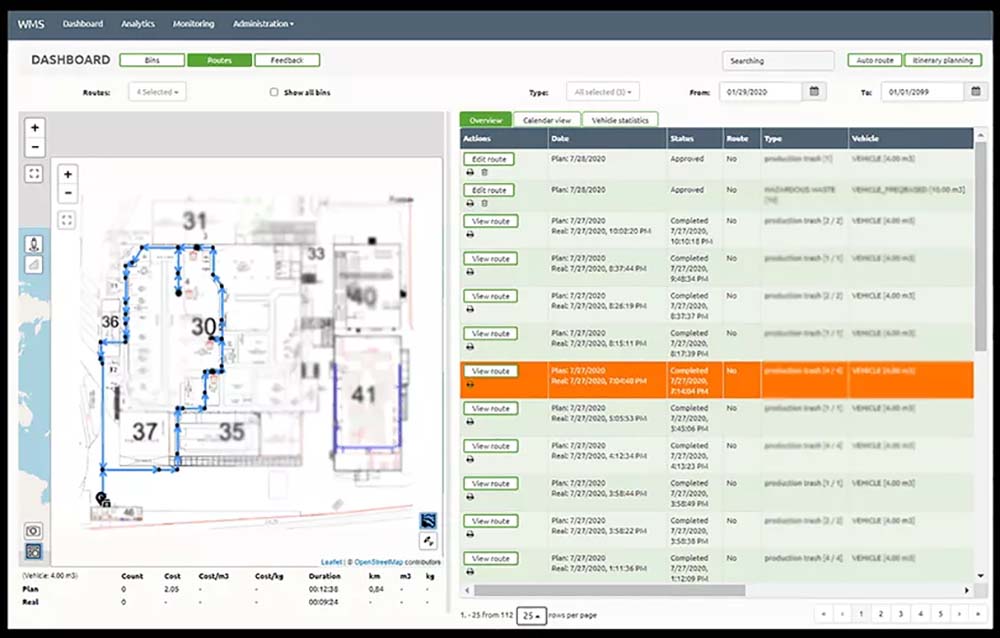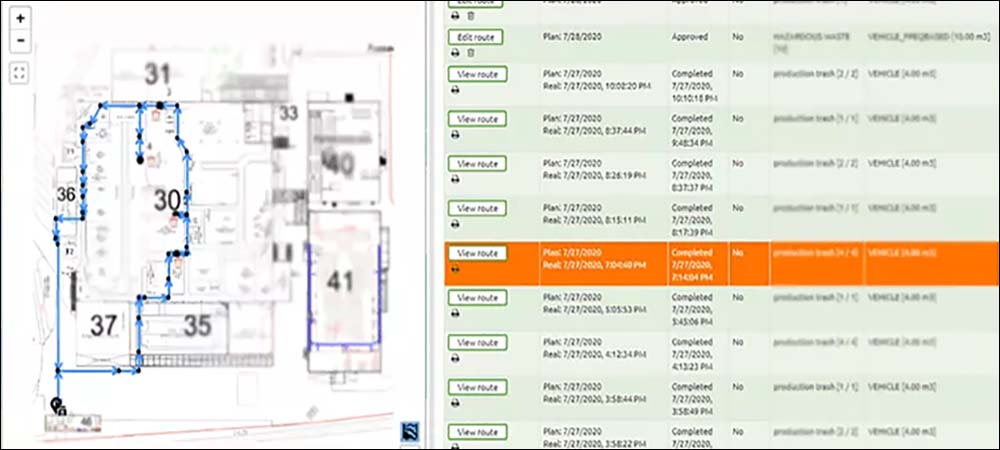A European agricultural equipment manufacturer is among the first customers to deploy an Internet of Things (IoT)-based waste-management system designed to boost the efficiency of trash collection at its busy assembly site and distribution center, while ensuring that garbage is disposed of according to local and national regulations and standards. The solution, known as Factory Waste Management, was developed by Sensoneo, using devices and a wireless network from Sigfox Germany.
The solution enables users to simply press a button when a bin needs to be emptied, while those tasked with collecting and replacing full bins with empties have access to data about each request, the bin’s location and the best route to conduct the process. They can then update information in their onboard tablet, including when they replaced a particular bin and its condition. What’s more, management can view real-time information regarding waste collection and conduct analytics based on historical data. The goal, according to the company, is to improve efficiency and reduce the volume of waste by helping businesses make strategic decisions regarding waste production and management.

Sensoneo is a waste-management technology firm based in Slovakia (see IoT Solution Tracks Waste Volume and Conditions in Bins). The company has carried out 320 deployments throughout 60 countries and is growing globally, according to Martin Basila, Sensoneo’s founder and CEO. Several months ago, it opened a legal entity in Phoenix, Ariz., known as Sensoneo USA, following a U.S. joint venture partnership. Its solutions are technology-agnostic and include a variety of IoT connectivity networks.
The company has traditionally served outdoor deployments, Basila says, and waste management inside factories is a uniquely challenging application. Manual labor is usually required, with individuals travelling along assembly site floors searching for bins that require emptying, or operators making phone calls when a bin needs to be emptied or replaced. Those picking up filled bins often operate a tractor vehicle that pulls those receptacles on wheels (typically, four or more at a time), delivering empties and then transporting the full bins to a designated disposal or recycling space.
The agricultural equipment manufacturer had employed such a system to replace filled waste containers at two facilities. Waste management is considered non-value-added work, according to a Sensoneo spokesperson, though it is nonetheless critical and often complex. Both the manufacturer and the spokesperson have asked not to be named in this article. Not only does the company need to track what is disposed of, but the materials need to be separated and properly routed for recycling or disposal purposes.
In addition, the frequency with which the bins need to be replaced and emptied is inconsistent. They could require attention every few hours or every half hour, and that can vary throughout a given day or week. “They are filled randomly,” the spokesperson explains. A system that tracked each bin’s location would be too costly for the company’s requirements, however, so management chose to implement Sensoneo’s solution, with buttons from Sigfox deployed at assembly stations where bins are used. By leveraging Sigfox connectivity, the system stands alone, without requiring Sensoneo’s existing Wi-Fi network.
Individuals fill bins with waste while conducting their daily work. When they see the levels have reached a predetermined level, such as 80 percent full, they can press a button on a Sigfox device. That status is then sent directly from the sensor device to Sigfox base stations and is transferred to Sigfox’s back-end software, says Elena Sztochay, Sigfox’s solution sales director. Sensoneo software collects the data through an application programming interface, she explains, then visualizes that information and provides it to the user.
The unique ID number of the sensor device on the assembly floor is linked to that workstation in the Sensoneo system, and it is displayed on a map of the facility as well. When the button is pressed, the software updates the bin’s status as requiring replacement with an empty receptacle at that specific station. The alert can be routed and displayed on a tablet mounted on track collectors’ vehicles.
The tablet, leveraging the Sensoneo software, displays all requests that have been made, as well as where each bin is located, and the software recommends the most efficient route to take as the drivers complete the task. The system provides the drivers with a tool to input their own feedback as they go about their work. They can select a prompt indicating which bin they are picking up, and they can also add information such as the bin’s condition, or take a picture and upload it to be linked to that specific bin location.
The solution reduces the average time for a trash-collecting trip, Basila says, while creating a record that confirms the processes completed for regulators, if needed. Additionally, the spokesperson says, the system serves as a training tool for individuals in a job that is often high-turnover. They can more easily follow the directions provided to them as they go about their work, and management can be alerted if they are falling behind.
With the data, Basila says, companies can conduct analysis that could reduce the cost and environmental impact of excess waste disposal. For instance, managers could view the data to identify how often bins at specific locations need to be emptied, as well as any particular locations that may require more or less bin coverage, based on the amount of waste produced. Management can also use the system to detect if a specific process is creating excess waste, then work with suppliers to reduce the amount being produced.
To customize the system according to their unique needs, Basila reports, users can employ Sensoneo’s drag-and-drop tool to select how quickly pickups need to be accomplished, along with how full each bin should be before this occurs. While the European company is using a Sigfox-based solution, other businesses may opt to employ narrowband Internet of Things (NB-IoT) or LoRaWAN technologies.


